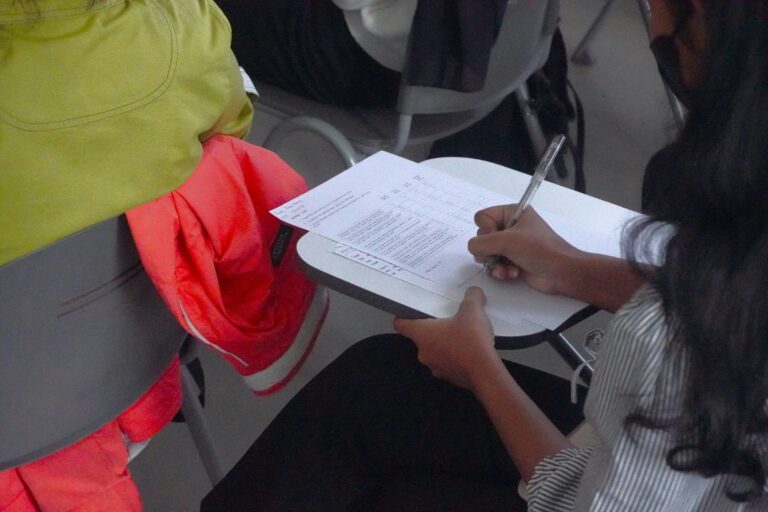IELTS Reading – jak rozpoznać i rozwiązywać różne typy zadań
Data ostatniej aktualizacji: 19.09.2025
W tym artykule przedstawiamy zestawienie najczęściej występujących typów pytań w sekcji Reading egzaminu IELTS wraz z przykładami. Dowiedzenie się, czego się spodziewać, pomoże Ci skuteczniej podejść do zadań w tej części testu oraz zwiększy Twoją pewność siebie podczas egzaminu.
Spis treści:
Ten artykuł przeczytasz w 4 minuty.
Typy pytań w IELTS Reading
Test czytania IELTS obejmuje różnorodne formaty pytań. Dobrze jest zapoznać się z nimi wcześniej, aby podczas egzaminu nic Cię nie zaskoczyło.
Rozpoznawanie informacji
a) Prawda / Fałsz / Brak informacji (True / False / Not Given)
W tym typie zadania analizujesz, czy dane stwierdzenie zgadza się z informacjami zawartymi w tekście (TRUE), jest z nimi sprzeczne (FALSE), czy też nie ma wystarczających danych, by to stwierdzić (NOT GIVEN). Pytania zwykle podążają za kolejnością treści w tekście.
Przykład: Questions 1-5
Do the following statements agree with the information given in Reading Passage 1?
In boxes 1-5 on your answer sheet, write:
TRUE – if the statement agrees with the text
FALSE – if the statement contradicts the text
NOT GIVEN – if the text doesn’t say
- The project was initially funded by private investors.
- Remote regions received more support than urban ones.
- The program’s outcomes were made public immediately.
- The media had limited access to progress reports.
- Participants were selected based on academic results.
b) Tak / Nie / Brak informacji (Yes / No / Not Given)
Ten format jest bardzo podobny, ale dotyczy opinii autora, a nie faktów. Pytania również są zwykle uporządkowane według kolejności pojawiania się informacji w tekście.
Przykład: Questions 6-10
Do the following statements agree with the writer’s claims in Reading Passage 1?
In boxes 6-10 on your answer sheet, write:
YES – if the statement agrees with the writer’s views
NO – if the statement contradicts the writer’s views
NOT GIVEN – if it’s unclear what the writer thinks
6. Investing in eco-tourism brings long-term economic benefits.
7. The researcher believes traditional farming methods are outdated.
8. Public transportation should be subsidized more heavily.
9. Environmental policies have improved significantly in recent years.
10. The author supports limiting tourist numbers in national parks.
Wybór wielokrotny
a) Jedna poprawna odpowiedź
Wybierz jedną poprawną opcję spośród czterech możliwych, by odpowiedzieć na pytanie lub dokończyć zdanie.
Przykład: Questions 11–13. Choose the correct letter, A, B, C or D.
11. Why did the wildlife preservation plan fail in the early stages?
A. There were conflicts with local communities
B. The funding was withdrawn unexpectedly
C. Environmental damage had already occurred
D. The team lacked scientific data
b) Wiele poprawnych odpowiedzi
Zazwyczaj należy wybrać dwie lub trzy odpowiedzi spośród pięciu opcji.
Przykład: Questions 14–15.
Choose TWO letters, A–E.
14. Which TWO of the following were reasons for declining interest in the program?
A. Limited access to online resources
B. A change in leadership
C. Unclear communication of objectives
D. Poor attendance at training sessions
E. Lack of technical support
Dopasowywanie
a) Dopasowywanie nagłówków
Dopasuj nagłówki do poszczególnych paragrafów lub sekcji artykułu. Wśród opcji znajdują się także nagłówki, które nie pasują nigdzie.
Przykład: Questions 16–20. Reading Passage 2 has 5 paragraphs, A–E. Choose the correct heading for each paragraph from the list below.
List of Headings
I. Growing concern over youth unemployment
II. Shifts in global work patterns
III. Education systems struggling to adapt
IV. Unexpected trends in the job market
V. The role of automation
VI. Government initiatives under scrutiny
VII. Positive outlook from economists
Paragraph A
Paragraph B
Paragraph C
Paragraph D
Paragraph E
b) Lokalizowanie informacji w tekście
Dopasuj konkretne informacje do paragrafów, w których się znajdują. Kolejność jest przypadkowa.
Przykład: Questions 21–25. Which paragraph (from A to E) contains the following information? Write the correct letter (A–E) in boxes 21–25.
21. A description of how digital tools support remote learning
22. Reference to a failed educational reform
23. An explanation of students’ resistance to change
24. A discussion on the impact of class size
25. Mention of plans for future investment in education
c) Dopasowywanie stwierdzeń do osób/rzeczy
Dopasuj stwierdzenia do konkretnych osób, miejsc itd.. Możliwe jest użycie jednej odpowiedzi więcej niż raz.
Przykład: Questions 26–29
Match each statement with the correct person, A–C.
NB: You may use any letter more than once.
26. Claims student motivation is linked to class atmosphere
27. Argues that exams don’t reflect real-world skills
28. Found a correlation between sleep and academic performance
29. Warns about over-reliance on online learning
List of researchers
A. Dr. James Patel
B. Prof. Linda Ng
C. Dr. Maria Leone
4. Końcówki zdań
Uzupełnij każde zdanie odpowiednią końcówką spośród podanych opcji.
Przykład:
Questions 30–33
Complete the sentences with the correct ending, A–D.
30. Students who participated in the pilot project
31. The government’s revised curriculum
32. One key benefit of the blended learning approach
33. Critics of the project argued that it
Answer choices
A. did not address students’ individual needs
B. helped improve student engagement
C. received widespread support from educators
D. showed significant progress in test results
5. Klasyfikacja
Dopasuj stwierdzenia do kategorii, np. grup wiekowych, krajów, typów szkół. Opcje mogą być użyte więcej niż raz.
Przykład: Questions 34–37. Classify the following statements as referring to:
A. Online-only courses
B. Traditional classroom settings
C. Hybrid (blended) learning models
34. Students had the most flexibility in scheduling
35. Teachers were able to provide more immediate feedback
36. Required a strong internet connection
37. Encouraged more collaboration among peers
Podsumowanie
Sekcja Reading w teście IELTS ocenia Twoją umiejętność szybkiego i efektywnego przetwarzania informacji z różnorodnych tekstów. Część ta zawiera 40 pytań opartych na 3 zróżnicowanych tekstach, które pochodzą z książek, magazynów, czasopism i gazet.
Ponieważ test zawiera wiele różnych typów zadań, ważne jest nie tylko zrozumienie treści tekstów, ale także umiejętność dokładnego rozpoznania, czego dotyczy każde pytanie. Rozwijanie takich umiejętności jak znajdowanie słów kluczowych, szybkie przeglądanie tekstu (skimming), rozpoznawanie parafraz oraz efektywne zarządzanie czasem znacząco poprawi Twoje wyniki i zwiększy pewność siebie podczas egzaminu.








